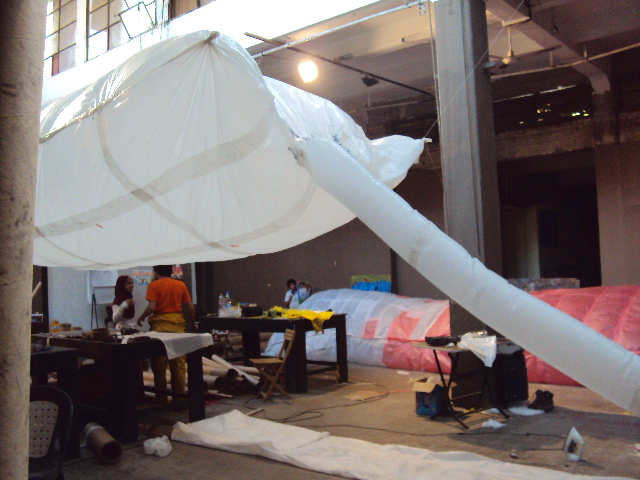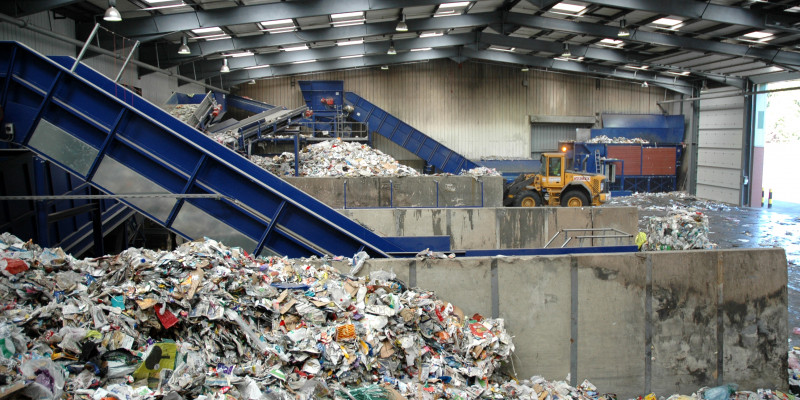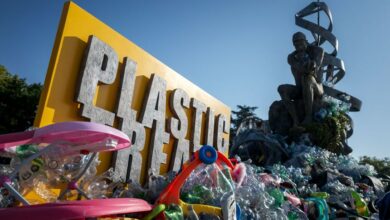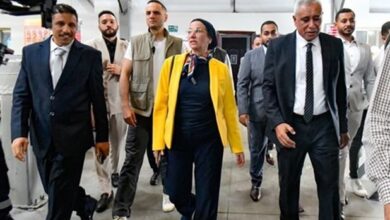
On Wednesday evening, the railway crossing that connects the Ard al-Lewa neighborhood with Mohandiseen was crowded with curious passers-by, as a rather poetic architectural structure was being installed: a shade made of plastic bags that seemed like a floating cloud.
For two weeks, the Madrid-based architectural collective Basurama, along with a group of Egyptian architects have been working at the Townhouse gallery’s factory space on developing a prototype for an architectural structure that is equally beautiful and functional. A key goal was to construct it from urban solid waste material; the base of the shelter was made of cardboard tubes, and plastic bags were connected and inflated with an electric fan to create a giant cloud.
The general feeling among the crowd was one of interest, but also mistrust. Quite expectedly, the neighborhood residents began asking what the mysterious object was for and who was providing it for their community, generating quite a bit of commotion.
When visiting Cairo for the first time, about a year ago, Basurama members were aware that they did not know much about the city, but they were “very curious to learn,” as Manu Polanco, a member of the collective, told Egypt Independent. They ran a three-day theoretical workshop and started organizing the Urban Solid Waste Project, a longer training program for young designers and architects that took place at the Townhouse gallery in late June.
The project, organized by Basurama and Cairo-based architect and professor Omar Nagati, involved designing, building and installing in public spaces an architectural prototype made of waste material. It had to be useful to the community and easy to reproduce if residents wished to do so. The group picked plastic bags as the material used to develop a design, as they are available in large quantities around the city. Then came the question of what it is that the city truly needs in the summer.
“What we miss in Cairo is shade, therefore we built an artificial cloud” says Juan López-Aranguren, a member of Basurama.
The public's interaction with the installation process and the work itself was the crucial outcome of the project.
Perception of public space in Cairo has dramatically changed over the past year and a half, and many initiatives have been dwelling with the topic. Projects like Mahatat for Contemporary Art and Al-Fan Midan (Art is a Square) focused on the new chances opened up for self-expression and art in public areas. The Urban Solid Waste Project presented a rather different approach. It meant to introduce an unexpected element in a public arena to purposely generate questions on the available resources and possibly inspire a different reuse of solid waste.
“When we first came to Cairo,” says López-Aranguren, “we noticed how public space here seems to be up for grabs. People use it in a fluid way, pushing its boundaries and always building new elements, although sometimes for individualistic purposes.” On Talaat Harb Street, for example, street vendors occupy the area between the road and the sidewalk, creating a dynamic threshold that expands and retreats according to the circumstances.
As Nagati points out, the creative reuse of waste material is nothing new to Cairo. It is everywhere. People informally build in public areas, providing solutions to day-to-day problems using what is at hand, which was very inspiring to Basurama. What the Urban Solid Waste Project focuses on, though, is not to simply reuse certain materials, but also to suggest shared solutions for the community’s problems.
The workshop aimed to activate a circular exchange of knowledge trying to avoid a didactic approach. The practices of dwellers and informal vendors inspired the building of an urban architectural prototype that would be placed into public spaces to possibly serve not just individuals but a larger community.
In all this, the installation phase of the project was part of the experimental process. “Public space is also a place where the unexpected happens,” says López-Arangure. People could modify the curious structure, use it according to the designers’ intentions or find alternative purposes for it, decide to reproduce it or even destroy it.
Indeed, the tube-like support of the cloud could be used in different ways and its function seems to be left intentionally unclear. It could be a stage or a children’s playground.
People’s reactions were unpredictable, especially since the project was meant to be a workshop for architects and designers and not a community-based initiative. As the organizers point out, the workshop did not include an active exchange with the communities supposed to benefit from the plastic cloud and its shade.
In addition to Ard al-Lewa, the cloud was planned to go to downtown’s Abdeen Square on the occasion of the monthly Al-Fan Midan arts festival. In this context, the installation went smoother and children interacted with the prototype in a playful way. The cloud was then supposed to move into a new residential area between Nasr City and the Ring Road.
The sites were purposely chosen for their different social structures. As Nagati explains, the railway crossing constitutes a transit area, normally hosting informal vendors and commercial activities, and marks an urban caesura that, at the same time, connecting and separating two very different neighborhoods. Abdeen Square is related to a more institutional setting, and has precise space boundaries that Al-Fan Midan uses to delimitate its outdoor performances. Finally, the new affordable housing area is a residential complex hosting Egyptian lower middle-class families, who decided to move to the fringes of the city. Unfortunately, this one last installation was cancelled, due to scheduling problems and differences in the expectations of the local community.
Whether this could be considered a best practice to put forward concrete solutions for a neighborhood’s problems is up for debate. Even though the organizers used their contacts with local leaders to plan the installations, a stronger involvement of the larger community might have at least avoided the overwhelming curiosity that workshop organizers and participants faced in Ard al-Lewa.
Indeed, the construction could also simply alienate people, especially in residential areas where no exceptional event is scheduled to happen, as opposed to Al-Fan Midan, and the installation was bound to be part of the urban environment for just a couple of days with very short time for local residents to familiarize themselves with it.




